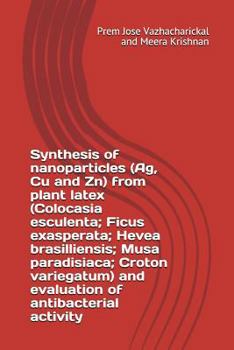Synthesis of nanoparticles (Ag, Cu and Zn) from plant latex (Colocasia esculenta; Ficus exasperata; Hevea brasilliensis; Musa paradisiaca; Croton variegatum) and evaluation of antibacterial activity
Nanotechnology is the field of study of materials at nanoscale. It involves the production, manipulation, and use of materials ranging in size from less than one micron to that of individual atoms from not only chemical approaches but also biological materials. Silver, Copper and Zinc nanoparticles were successfully synthesised from Silver nitrate, Copper sulphate and Zinc sulphate respectively through a simple green and natural route using latex of 5 different plant taxa. Nanoparticle formation was proved by UV-vis spectroscopy. The antimicrobial well diffusion method used was give information about the antibacterial activity of latex nanoparticles towards 5 different bacterial species by measuring the zone of inhibition. The use of two dilutions of latex solution was used for the comparative study of zone of inhibition. As nanoparticles have great application in medical world like gene therapy, cancer therapy, drug delivery, etc. So medical world also accept the plant world for nanoparticle synthesis and mainly welcome the angiosperms for their potentiality of synthesis of non-polluted, environmentally acceptable, safety for human health nanoparticles.
Format:Paperback
Language:English
ISBN:1983169862
ISBN13:9781983169861
Release Date:June 2018
Publisher:Independently Published
Length:86 Pages
Weight:0.30 lbs.
Dimensions:0.2" x 6.0" x 9.0"
Customer Reviews
0 rating





